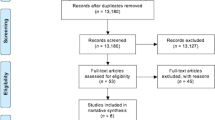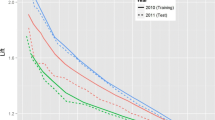Abstract
This paper describes the development of a tree-based decision model to predict the severity of pediatric asthma exacerbations in the emergency department (ED) at 2 h following triage. The model was constructed from retrospective patient data abstracted from the ED charts. The original data was preprocessed to eliminate questionable patient records and to normalize values of age-dependent clinical attributes. The model uses attributes routinely collected in the ED and provides predictions even for incomplete observations. Its performance was verified on independent validating data (split-sample validation) where it demonstrated AUC (area under ROC curve) of 0.83, sensitivity of 84%, specificity of 71% and the Brier score of 0.18. The model is intended to supplement an asthma clinical practice guideline, however, it can be also used as a stand-alone decision tool.




Similar content being viewed by others
References
McDermott, M. F., Grant, E. N., Turner-Roan, K., Li, T., and Weiss, K. B., Asthma care practices in Chicago-area emergency departments. Chest. 116(4 Suppl 1):167–173, 1999. doi:10.1378/chest.116.suppl_2.167S.
Barnett, P. J., and Oberklaid, F., Acute asthma in children: Evaluation of management in a hospital emergency department. Med. J. Aust. 154(11):729–733, 1991.
Scribano, P. V., Lerer, T., Kennedy, D., and Cloutier, M. M., Provider adherence to a clinical practice guideline for acute asthma in a pediatric emergency department. Acad. Emerg. Med. 8(12):1147–1152, 2001. doi:10.1111/j.1553-2712.2001.tb01131.x.
National Heart, Lung and Blood Institute, Guidelines for the diagnosis and management of asthma. Available from http://www.nhlbi.nih.gov/guidelines/asthma/index.htm. Last accessed on September 15, 2008.
Canadian Association of Emergency Physicians, Guidelines for emergency management of paediatric asthma. Available from http://www.caep.ca/template.asp?id-3272F9E47A064ED4820C829B15BB1BCD. Last accessed on September 15, 2008.
Shiffman, R. N., Michel, G., Essaihi, A., and Thornquist, E., Bridging the guideline implementation gap: A systematic, document-centered approach to guideline implementation. J. Am. Med. Inform. Assoc. 11(5):418–426, 2004. doi:10.1197/jamia.M1444.
Waitman, L. R., and Miller, R. A., Pragmatics of implementing guidelines on the front lines. J. Am. Med. Inform. Assoc. 11(5):436–438, 2004. doi:10.1197/jamia.M1621.
van der Windt, D. A., Nagelkerke, A. F., Bouter, L. M., Dankert-Roelse, J. E., and Veerman, A. J., Clinical scores for acute asthma in pre-school children. A review of the literature. J. Clin. Epidemiol. 47(6):635–646, 1994. doi:10.1016/0895-4356(94)90211-9.
van der Windt, D. A., Promises and pitfalls in the evaluation of pediatric asthma scores. J. Pediatr. 137(6):744–746, 2000. doi:10.1067/mpd.2000.111458.
Bishop, J., Carlin, J., and Nolan, T., Evaluation of the properties and reliability of a clinical severity scale for acute asthma in children. J. Clin. Epidemiol. 45(1):71–76, 1992. doi:10.1016/0895-4356(92)90190-X.
Parkin, P. C., Macarthur, C., Saunders, N. R., Diamond, S. A., and Winders, P. M., Development of a clinical asthma score for use in hospitalized children between 1 and 5 years of age. J. Clin. Epidemiol. 49(8):821–825, 1996. doi:10.1016/0895-4356(96)00027-3.
Gorelick, M. H., Stevens, M. W., Schultz, T. R., and Scribano, P. V., Performance of a novel clinical score, the Pediatric Asthma Severity Score (PASS), in the evaluation of acute asthma. Acad. Emerg. Med. 11(1):10–18, 2004.
Ducharme, F. M., Chalut, D., Plotnick, L., Savdie, C., Kudirka, D., Zhang, X., Meng, L., and McGillivray, D., The pediatric respiratory assessment measure: A valid clinical score for assessing acute asthma severity from toddlers to teenagers. J. Pediatr. 152(4):476–480, 2008. doi:10.1016/j.jpeds.2007.08.034.
Smith, S. R., Baty, J. D., and Hodge, D., Validation of the pulmonary score: An asthma severity score for children. Acad. Emerg. Med. 9(2):99–104, 2002. doi:10.1111/j.1553-2712.2002.tb00223.x.
Gorelick, M. H., Stevens, M. W., Schultz, T. R., and Scribano, P. V., Difficulty in obtaining peak expiratory flow measurements in children with acute asthma. Pediatr. Emerg. Care. 20(1):22–26, 2004. doi:10.1097/01.pec.0000106239.72265.16.
Hanson, C. W., and Marshall, B. E., Artificial intelligence applications in the intensive care unit. Crit. Care Med. 29(2):427–435, 2001. doi:10.1097/00003246-200102000-00038.
Podgorelec, V., Kokol, P., Stiglic, B., and Rozman, I., Decision trees: An overview and their use in medicine. J. Med. Syst. 26(5):445–463, 2002. doi:10.1023/A:1016409317640.
Grassi, M., Villani, S., and Marinoni, A., Classification methods for the identification of ‘case’ in epidemiological diagnosis of asthma. Eur. J. Epidemiol. 17(1):19–29, 2001. doi:10.1023/A:1010987521885.
Becker, A. B., Nelson, N. A., and Simons, F. E., The pulmonary index: Assessment of a clinical score for asthma. Am. J. Dis. Child. 138(6):574–576, 1984.
Kelly, A. M., Kerr, D., and Powell, C., Is severity assessment after one hour of treatment better for predicting the need for admission in acute asthma? Respir. Med. 98(8):777–781, 2004. doi:10.1016/j.rmed.2004.01.008.
Schuh, S., Johnson, D., Stephens, D., Callahan, S., and Canny, G., Hospitalization patterns in severe acute asthma in children. Pediatr. Pulmonol. 23(3):184–192, 1997. doi:10.1002/(SICI)1099-0496(199703)23:3<184::AID-PPUL3>3.0.CO;2-O.
Smith, M., Iqbal, S. M. S. I., Rowe, B. H., and N’Diaye, T., Corticosteroids for hospitalised children with acute asthma. Cochrane Database Syst. Rev. 1:CD002886, 2003.
Pearson, S. D., Goulart-Fisher, D., and Lee, T. H., Critical pathways as a strategy for improving care: Problems and potential. Ann. Intern. Med. 123(12):941–948, 1995.
de Rooij, S. E., Abu-Hanna, A., Levi, M., and de Jonge, E., Identification of high-risk subgroups in very elderly intensive care unit patients. Crit. Care. 11(2):R33, 2007. doi:10.1186/cc5716.
Abu-Hanna, A., and Lucas, P. J. F., Prognostic models in medicine. AI and statistical approaches. Methods Inf. Med. 40:1–5, 2001.
Quinlan, R., C4.5: programs for machine learning. Morgan Kaufmann, San Mateo, CA, p. 302, 1993.
Witten, I. H., and Frank, E., Data mining: Practical machine learning tools and techniques, 2nd edition. Morgan Kaufmann, San Francisco, CA, p. 525, 2005.
Breiman, L., Friedman, J., Stone, C. J., and Olshen, R. A., Classification and regression trees. Wadsworth & Brooks, New York, 1984.
Kohavi, R., and Quinlan, R., Decision-tree discovery. In: Klosgen, W., and Zytkow, J. M. (Eds.), Handbook of Data Mining and Knowledge Discovery. Oxford University Press, New York, pp. 267–276, 2002.
Cios, K. J., and Moore, G. W., Uniqueness of medical data mining. Artif. Intell. Med. 26(1–2):1–24, 2002. doi:10.1016/S0933-3657(02)00049-0.
Beck, J. R., Garcia, M. E., Zhong, M., Georgiopoulos, M., and Anagnostopoulos, G. C., A backward adjusting strategy and optimization of the C4.5 parameters to improve C4.5’s performance. In: Wilson, D., and Lane, H. C., (Eds.), Proceedings of the 21st International Florida Artificial Intelligence Research Society (FLAIRS) Conference (FLAIRS 2008), Coconut Grove, Florida, USA, May 15–17, 2008, p. 35–40.
Faraggi, D., and Reiser, B., Estimation of the area under the ROC curve. Stat. Med. 21(20):3093–3106, 2002. doi:10.1002/sim.1228.
Fawcett, T., An introduction to ROC analysis. Pattern Recognit. Lett. 27(8):861–874, 2006. doi:10.1016/j.patrec.2005.10.010.
Grzymala-Busse, J.W., and Hu, M., A comparison of several approaches to missing attribute values in data mining. In: Ziarko, W., and Yao, Y. Y., (Eds.), Rough Sets and current Trends in Computing. Second International Conference, RSCTC 2000 Banff, Canada, October 16–19, 2000. Revised papers. Berlin: Springer,, p. 378–385, 2000.
O’Sullivan, D., Elazmeh, W., Wilk, S., Farion, K., Matwin, S., Michalowski, W., Sehatkar, M., Using secondary knowledge to support decision tree classification of retrospective clinical data. In: Ras, Z, Zighed, D, and Tsumoto, S, (Eds.), Mining Complex Data. ECML/PKDD 2007 Third International Workshop, MCD 2007, Warsaw, Poland, September 17–21, 2007. Revised selected papers. Berlin: Springer, p. 238–251, 2008.
Acuna, E., and Rodriguez, C., The treatment of missing values and its effect in the classifier accuracy. In: Banks, D., House, L., McMorris, F. R., Arabie, P., and Gaul, W., (Eds.), Classification, Clustering and Data Mining Applications. Proceedings of the Meeting of the International Federation of Classification Societies (IFCS), Illinois Institute of Technology, Chicago, 15–18 July 2004. Berlin: Springer, p. 639–648, 2004.
Turney, P., and Halasz, M., Contextual normalization applied to aircraft gas turbine engine diagnosis. J. Appl. Intell. 3:109–19, 1993. doi:10.1007/BF00871892.
Chey, T., Jalaludin, B., Hanson, R., and Leeder, S., Validation of a predictive model for asthma admission in children: How accurate is it for predicting admissions? J. Clin. Epidemiol. 52(12):1157–1163, 1999. doi:10.1016/S0895-4356(99)00111-0.
Crighton, E. J., Mamdani, M. M., and Upshur, R. E. G., A population based time series analysis of asthma hospitalisations in Ontario, Canada: 1988 to 2000. BMC Health Serv. Res. 1(1):7–7, 2001. doi:10.1186/1472-6963-1-7.
Peek, N., Arts, D. G. T., Bosman, R. J., van der Voort, P. H. J., and de Keizer, N. F., External validation of prognostic models for critically ill patients required substantial sample sizes. J. Clin. Epidemiol. 60:491–501, 2007.
Obuchowski, N. A., and Lieber, M. L., Confidence intervals for the receiver operating characteristic area in studies with small samples. Acad. Radiol. 5(8):561–571, 1998. doi:10.1016/S1076-6332(98)80208-0.
Zimmerman, J. E., Kramer, A. A., McNair, D. S., and Malila, F. M., Acute physiology and chronic health evaluation (APACHE) IV: Hospital mortality assessment for today’s critically ill patients. Crit. Care Med. 34(5):1297–1310, 2006. doi:10.1097/01.CCM.0000215112.84523.F0.
Li, D., German, D., Lulla, S., Thomas, R. G., and Wilson, S. R., Prospective study of hospitalization for asthma. A preliminary risk factor model. Am. J. Respir. Crit. Care Med. 151(3 Pt 1):647–655, 1995.
Holt, G., Letter to the Editor. Clinical benchmarking for the validation of AI medical diagnostic classifiers. Artif. Intell. Med. 35(3):259–260, 2005. doi:10.1016/j.artmed.2005.10.001.
Kerem, E., Tibshirani, R., Canny, G., Bentur, L., Reisman, J., Schuh, S., Stein, R., and Levison, H., Predicting the need for hospitalization in children with acute asthma. Chest. 98(6):1355–1361, 1990. doi:10.1378/chest.98.6.1355.
Acknowledgements
The authors would like to thank William Klement and Morvarid Sehatkar from the School of Information Technology and Engineering, University of Ottawa for help with data analysis and Chris Drummond and Peter Turney from the National Research Council of Canada for advice about contextual normalization. The authors also would like to thank anonymous reviewers for helpful comments and suggestions. Research reported here was supported by NSERC-CIHR grant from the CHRP program.
Author information
Authors and Affiliations
Corresponding author
Rights and permissions
About this article
Cite this article
Farion, K., Michalowski, W., Wilk, S. et al. A Tree-Based Decision Model to Support Prediction of the Severity of Asthma Exacerbations in Children. J Med Syst 34, 551–562 (2010). https://doi.org/10.1007/s10916-009-9268-7
Received:
Accepted:
Published:
Issue Date:
DOI: https://doi.org/10.1007/s10916-009-9268-7




